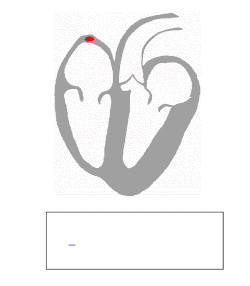Heart Autorhythmicity
(Redirected from Action Potential and Autorhythmicity)
Heart is a hollow, muscular organ responsible for maintainance of blood flow. It accomplishes that function by being able not only to contract, but to do it without the need of any external stimulus- has autorhythmical capacity. Is in the myocardium (it´s middle layer), that are present the specialized cells that control all it´s activities.
Contraction of Heart[edit | edit source]
The heart contracts due to the conductance of action potentials through it´s cells.
Heart cells[edit | edit source]
There are 3 main types of cardiac muscle cells (myocytes) in the heart, which account for its function:
- Atrial and ventricular: these fibres contract in much the same way as skeletal muscle, except that the duration of contraction is longer;
- Excitatory/conducting: fibres with capacity of self excitation and conduction of action potentials throughout the heart; are mainly composed of cells of Sino-Atrial (SA) node, Atrio-Ventricular (AV) node and Purkyně fibres.
 For more information see [Conductive System of the Heart (Wikipedia)].
For more information see [Conductive System of the Heart (Wikipedia)].
Channels[edit | edit source]
The conductance of action potentials from cell to cell in the heart is dependent on the channels present on the surface of the myocyte membranes.
The 3 types of channels present in atrial and ventricular fibres responsible for the spread of the action potentials are:
- Voltage Dependent Na+ channels (also called fast Na+ channels);
- Voltage dependent Ca2+ channels (also called slow Ca2+ channels);
- Voltage dependent K+ channels.
Action Potential[edit | edit source]
Using a ventricular myocyte as a base for analysis, what happens is the following:
- Before any stimulus, resting membrane potential of a cell is −85/−90 mV;
- When there is a stimulus, some Na+ channels are opened, allowing the ion to pour into the cell, leading to the depolarization of the membrane;
- When depolarization reaches the threshold level, all the fast Na+ channels open, leading to a spike in depolarization;
- When spike is reached, the fast Na+ channels become inactivated at the same time that the slow Ca2+ channels and some K+ channels are opened. This means that Ca2+ ions are pouring inside the cell, while K+ ions are leaking from the cell, leading to a plateau phase;
- After about 0.2 s, slow Ca2+ channels start to close, while more K+ channels open, leading to a new phase, where more positively charged ions are leaking out of the cell than pouring in, leading the repolarization of the membrane, back to its resting potential.
Additional considerations[edit | edit source]
- Atrial action potentials are faster, lasting only 0.2 s because it has fewer slow Ca2+ channels, leading to an almost absent plateau;
- Action potentials in ventricular cells last about 0.3 s, 100 times more than a skeletal muscle cell.
Autorhythmycity of the Heart[edit | edit source]
Autorhythmic cells of the heart are composed of cells of SA node, AV node, Purkyně fibres. However, in physiological conditions, the SA node is the one that sets the pace for the rest of the heart- is the pacemaker, discharging at a rate of 70/80 bpm.
The excitatory/conducting cells of the heart are the fibres responsible for the autorhthmicity of the heart.
Channels[edit | edit source]
- nhj‘’Funny‘’ channels (small Na+ leaky channels);
- Voltage dependent Ca2+ channels (also called slow Ca2+ channels);
- Voltage dependent K+ channels.
Pacemaker Action Potential[edit | edit source]
Using SA node fibre as a base for analysis, what happens is the following:
- Resting membrane potential is −55/−60 mV;
- The funny Na+ channels are open, allowing ions to constantly pour into the cell, slowly depolarizing the membrane;
- When threshold is reached, slow Ca2+ channels open, causing the action potential;
- About 0.1−0.15 s after, the slow Ca2+ channels become inactivated, and K+ channels open;
- Ouflux of K+ ions, and low permeability of the membrane to the Na+ ions, allows repolarization, ending the action potential.
- Then, K+ channels begin to close, and more funny channels open, causing positive drift of membrane potential upward once more, giving rise to new action potential (phenomenon is cyclical).
Additional considerations[edit | edit source]
- Not only the SA node fibres (which discharge at a rate of 70/80 bpm), but also AV node (which discharge at a rate of 40/60 bpm) and Purkyně fibres (which discharge at a rate of 15/40 bpm), have the ability to form action potentials. However, because the SA node is the one with the fastest rate of firing, it is considered the pacemaker of the heart;
- In case the SA node stops functioning or decreases its pace, any of the other 2 can take its place;
- ‘’Funny‘’ channels (small Na+ leaky channels) are not voltage gated, and are continuously open;
- The inherent leakiness of SA node fibres to Na+ ions is what causes their self-excitation;
- Action potentials created in pacemaker are sent to the rest of the heart through the conducting fibres allowing it to contract, executing its pumping function.
- Pacemaker cells do not need any external stimulus in order to create action potentials, in contrary to the rest of cardiac cells and skeletal cells;
- However, increase or decrease of heart rate is controlled by sympathetic and parasympathetic systems, respectively.
Links[edit | edit source]
Related articles[edit | edit source]
External links[edit | edit source]
Sources[edit | edit source]
- Hall, John E; "Guyton and Hall, Textbook of Medical Physiology", 12th Edition; Sauders Elsevier Editors;
- Kapit, Macey, Meisami; "The Physiology Coloring Book", 2nd Edition; HarperCollins Publishers;
- Lindem, Roger and Ward, Jeremy; "Physiology at a Glance", 1st Edition, 2005; Blackwell Publishers;
- http://www.ncbi.nlm.nih.gov/pubmed/20019407;
- Pic1 at:http://www.google.com/images?um=1&hl=pt-pt&biw=1280&bih=673&tbs=isch:1&sa=1&q=ventricular+action+potential&aq=f&aqi=g1&aql=&oq=&gs_rfai=;
- Pic2 at: http://www.google.com/images?um=1&hl=pt-pt&biw=1280&bih=673&tbs=isch:1&sa=1&q=pacemaker+action+potential&aq=f&aqi=&aql=&oq=&gs_rfai=




